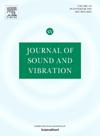Optimization of acoustic porous material absorbers modeled as rigid multiple microducts networks: Metamaterial design using additive manufacturing
IF 4.3
2区 工程技术
Q1 ACOUSTICS
引用次数: 0
Abstract
This research presents a strategy to enhancing sound absorption in porous acoustic metamaterials through the optimization of micro-duct networks. The study employs a combination of analytical and numerical methods, systematically adjusting micro-duct diameters within a 2D grid to optimize absorption coefficients at specific frequency bands. The Finite Element Transfer Method (FETM) is utilized for modeling, supported by a multi-objective function influenced by the surface impedance of the network. This approach ensures practical applicability and manufacturability of the designed metamaterial. A significant aspect of the study is the development of an analytical mobility matrix for each microduct, integrated through the Transfer Matrix Method using the visco-thermal dissipation theory. This integration results in a physically coherent model, for which a semi-analytical sensitivity analysis related to the microduct diameters can be directly performed. The optimization employs the Method of Moving Asymptotes (MMA), effectively managing the complexity associated with a large number of design variables. Subsequently, the optimized structure is adapted into a 3D grid, facilitating prototype creation using Additive Manufacturing Technology (AMT) with a specific polymer material. The research methodology is validated through four distinct test cases, each demonstrating the efficacy and adaptability of the optimization tools and techniques. Experimental validation, conducted using an impedance tube, indicates a significant shift in the first absorption maximum from 2500 Hz to 1000 Hz, achieved without altering the material thickness. Additional validation through 3D Finite Element Method (FEM) modeling, which includes visco-thermal effects, further confirms the acoustic efficiency of the final designs. While the potential for achieving lower sub-wavelength conditions is recognized, the study opts for simpler structures, considering the current limitations of 3D printing technology. This study contributes to both theoretical understanding and practical application in acoustic material design, emphasizing the potential for customizing materials to specific frequency ranges. The integration of FETM modeling with MMA provides a systematic and effective approach for optimizing acoustic materials, particularly in enhancing absorption at lower frequencies.
以刚性多微导管网络为模型的多孔吸声材料的优化:利用快速成型技术进行超材料设计
这项研究提出了一种通过优化微导网络来增强多孔声学超材料吸声效果的策略。研究采用分析和数值方法相结合的方式,在二维网格内系统地调整微导管直径,以优化特定频段的吸声系数。利用有限元传输法(FETM)进行建模,并辅以受网络表面阻抗影响的多目标函数。这种方法确保了所设计超材料的实用性和可制造性。这项研究的一个重要方面是为每个微导体开发了一个分析性流动矩阵,并利用粘热耗散理论通过传递矩阵法进行了整合。这种整合产生了一个物理上一致的模型,可以直接进行与微导线直径相关的半分析灵敏度分析。优化采用了渐近移动法(MMA),有效地控制了与大量设计变量相关的复杂性。随后,优化后的结构被调整为三维网格,从而便于使用增材制造技术(AMT)和特定聚合物材料创建原型。研究方法通过四个不同的测试案例进行了验证,每个案例都展示了优化工具和技术的有效性和适应性。使用阻抗管进行的实验验证表明,在不改变材料厚度的情况下,第一吸收最大值从 2500 Hz 显著降低到 1000 Hz。通过三维有限元法(FEM)建模(包括粘热效应)进行的其他验证进一步证实了最终设计的声学效率。虽然认识到实现更低亚波长条件的潜力,但考虑到目前三维打印技术的局限性,本研究选择了更简单的结构。这项研究有助于声学材料设计的理论理解和实际应用,强调了根据特定频率范围定制材料的潜力。FETM 建模与 MMA 的整合为优化声学材料提供了系统而有效的方法,尤其是在增强低频吸收方面。
本文章由计算机程序翻译,如有差异,请以英文原文为准。
求助全文
约1分钟内获得全文
求助全文
来源期刊

Journal of Sound and Vibration
工程技术-工程:机械
CiteScore
9.10
自引率
10.60%
发文量
551
审稿时长
69 days
期刊介绍:
The Journal of Sound and Vibration (JSV) is an independent journal devoted to the prompt publication of original papers, both theoretical and experimental, that provide new information on any aspect of sound or vibration. There is an emphasis on fundamental work that has potential for practical application.
JSV was founded and operates on the premise that the subject of sound and vibration requires a journal that publishes papers of a high technical standard across the various subdisciplines, thus facilitating awareness of techniques and discoveries in one area that may be applicable in others.
 求助内容:
求助内容: 应助结果提醒方式:
应助结果提醒方式:


